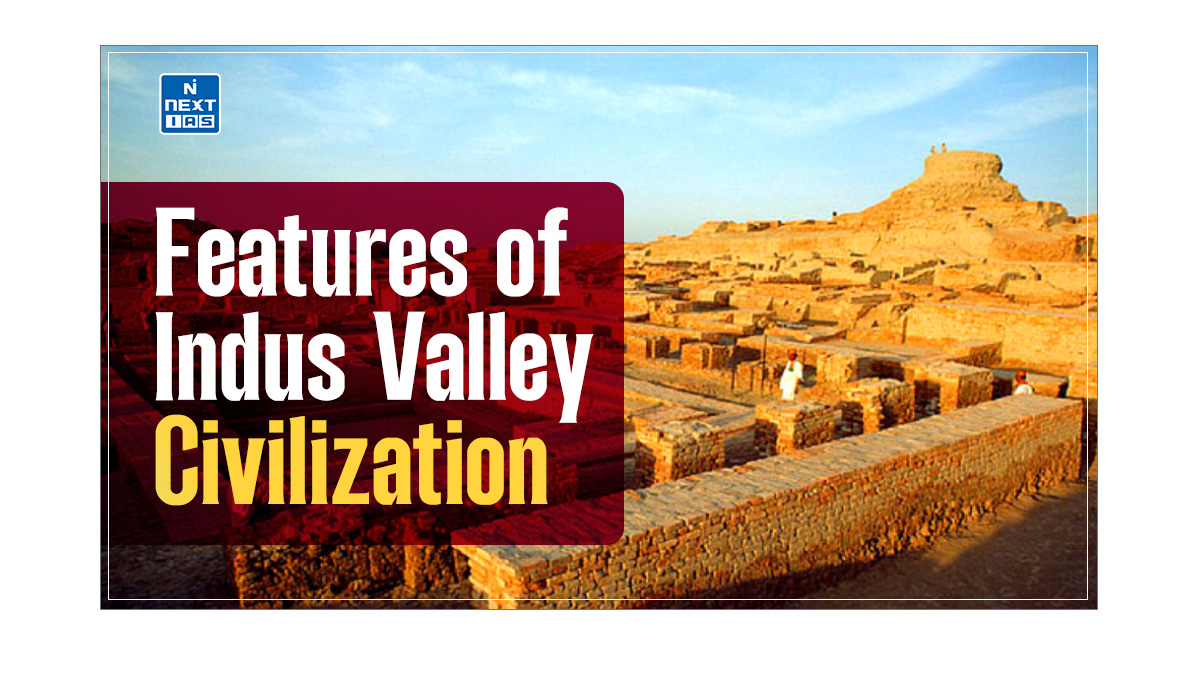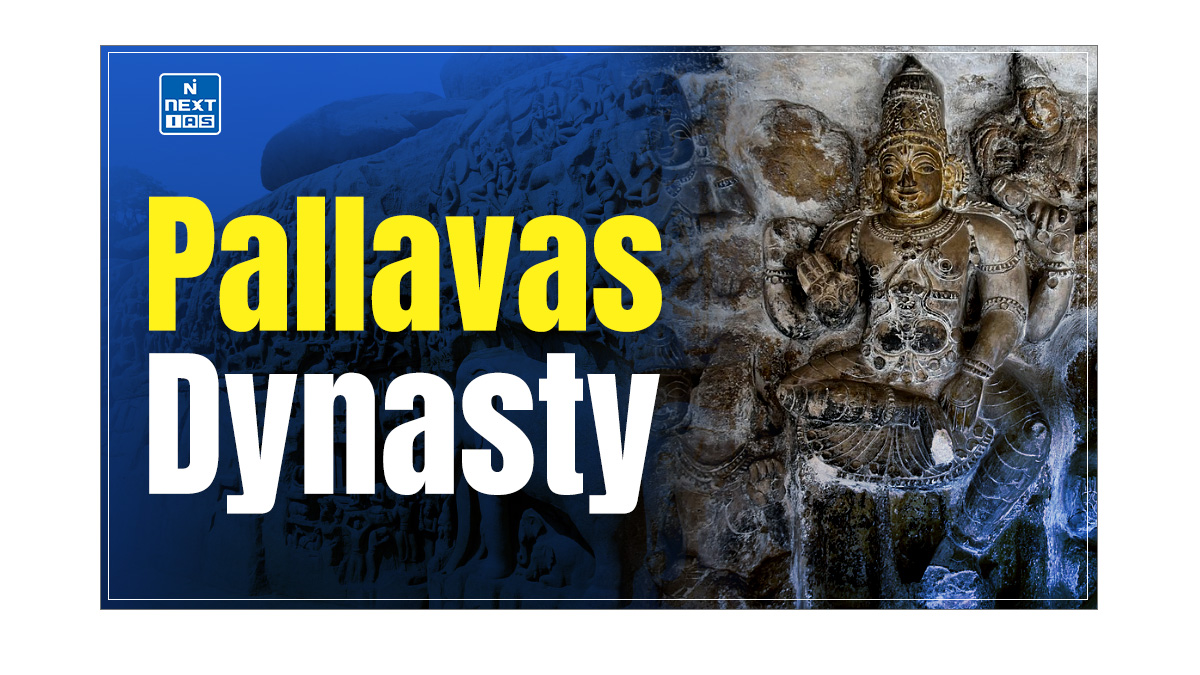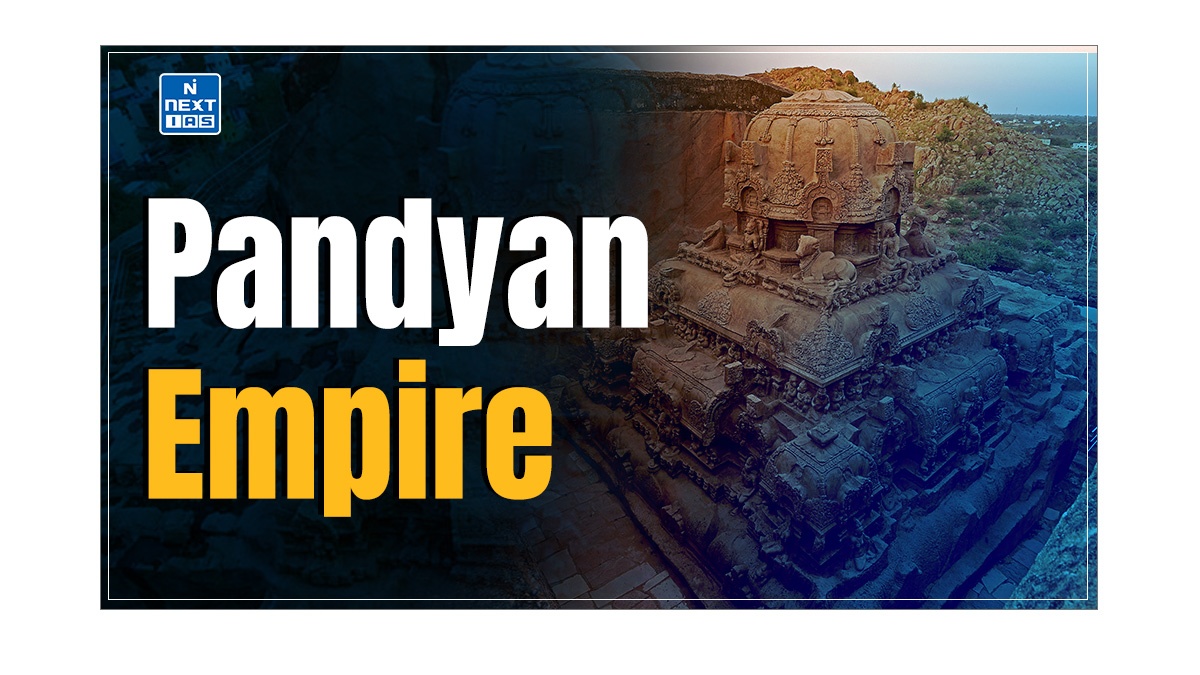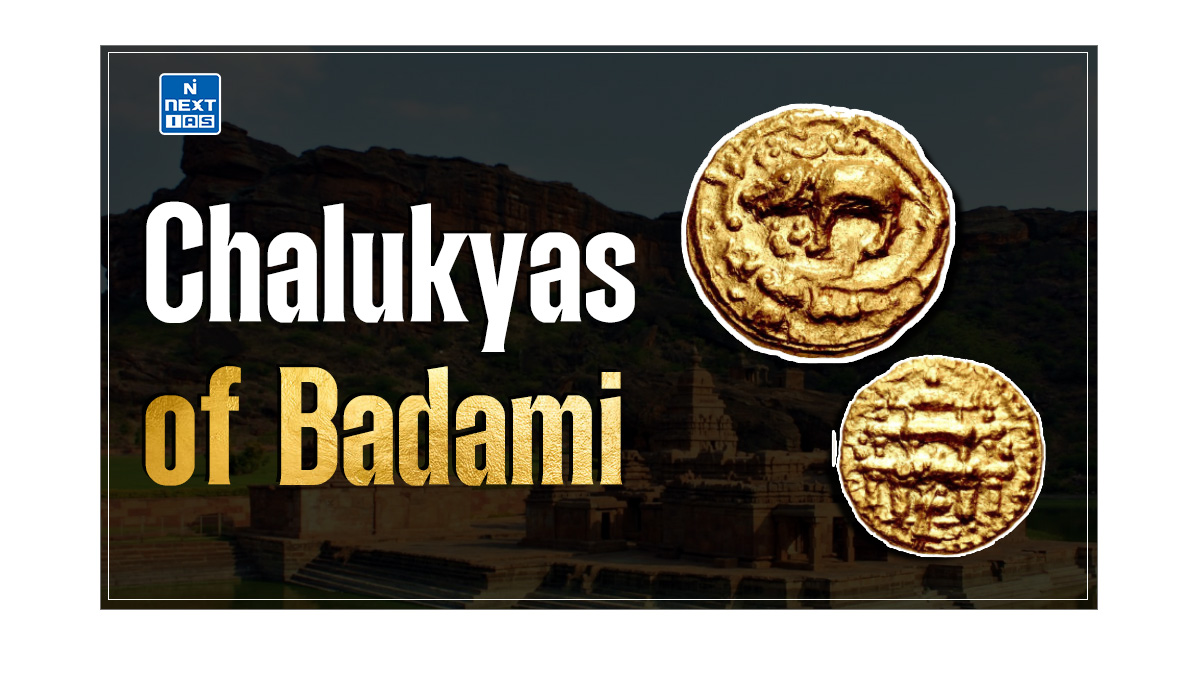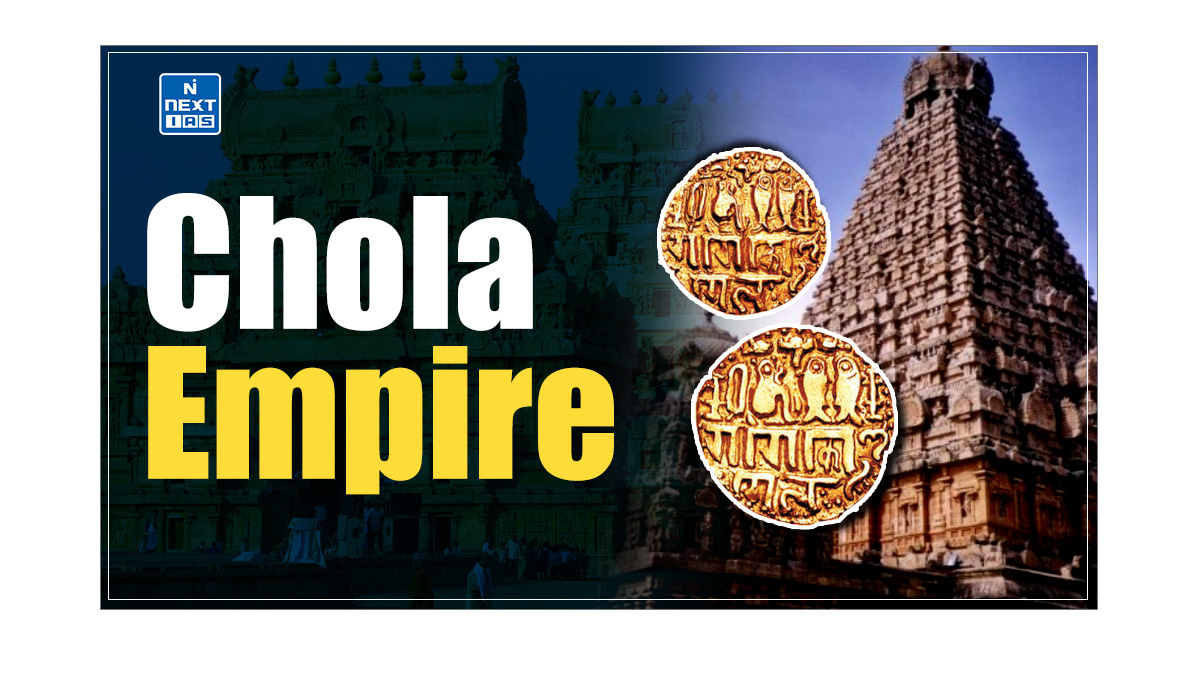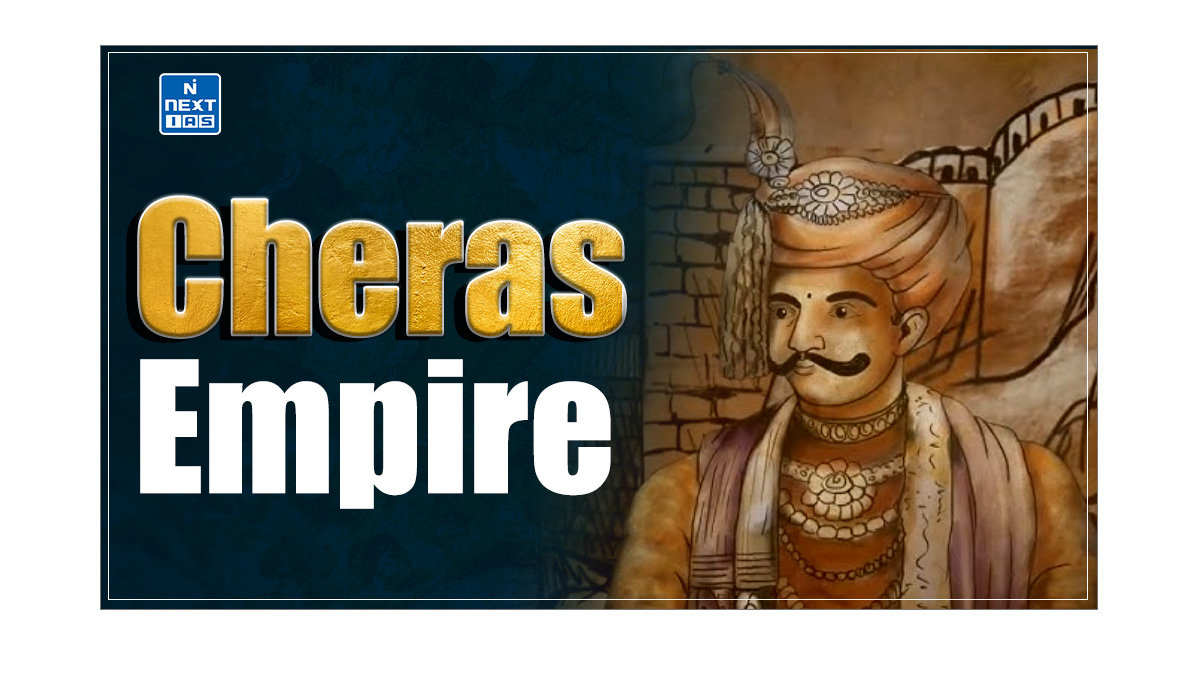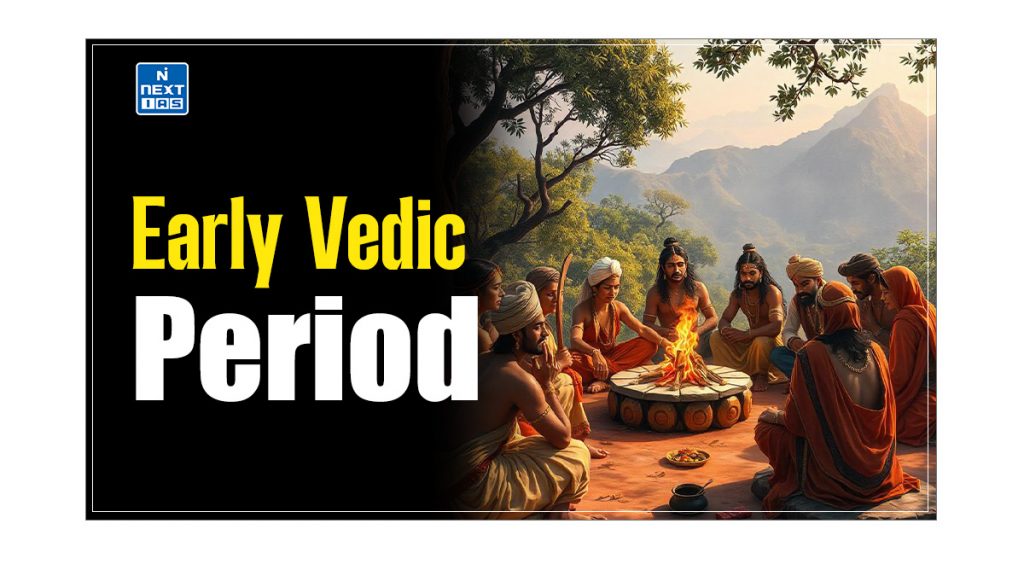
The Early Vedic Period (1500 – 1000 BCE) marks a foundational period in the history of the Indian subcontinent characterised by the settlement of Indo-Aryans in the northwestern regions, including the Punjab and the Sarasvati River basin. Its significance lies in its foundational influence on Indian culture and religious practices, which continued to evolve throughout the Vedic period. This article aims to study in detail the various aspects of the Early Vedic Period, including its social structure, religious beliefs, and cultural practices.
About Early Vedic Period (EVP)
- The Early Vedic Period (1500 – 1000 BCE) marks when the Indo-Aryans settled in the northwestern parts of the Indian subcontinent, primarily in the Punjab and the Sarasvati River basin.
- During this time, society was predominantly pastoral, with cattle rearing a major occupation alongside agriculture.
- The Rigveda, the oldest of the Vedic texts, was composed during this period. It reflects the people’s religious beliefs, social structure, and daily lives.
- The Early Vedic Period was characterised by a simple, clan-based society where the family and the clan (Jana) were central to social organisation.
- Society was governed by tribal chiefs (Rajans), who led their people in both governance and warfare.
- Religious practices centred on worshipping natural forces and deities such as Agni, Indra, and Varuna through elaborate rituals and sacrifices.
Political Structure of Early Vedic Period
The political structure of the Early Vedic Period can be seen as follows:
- The administrative machinery of the Aryans in the Rig Vedic period functioned with the tribal chief at the centre due to his successful leadership in war.
- He was called Rajan. The Rajan was not an absolute monarch, as the tribe’s government was partially responsible for tribal councils like sabha, samiti, gana, and vidatha.
- The two most important assemblies were the Sabha and Samiti, which were so influential that chiefs or kings sought their support.
- These clan-based assemblies exercised deliberative, military, and religious functions.
- Even women attended the sabha and the vidatha. The raja’s post was generally hereditary, but there are mentions of the election of the king by the tribal assembly (samiti).
Functionaries Assisting Kings of Early Vedic Period
- The most important official was the Purohita, who, through his sacrifices, ensured the tribe’s prosperity in peace and victory in war.
- Two priests who played a major role during the Rig Veda period were Vasishtha and Vishvamitra.
- Vasishtha was conservative, while Vishvamitra was liberal and composed the Gayatri mantra to expand the Aryan world. The priests inspired the tribal chiefs to action and praised their exploits.
- The next important functionary was the Senani (General), responsible under the king for minor campaigns and cattle raids against neighbouring tribes.
- There was no regular or standing army; in times of war, the king mustered a militia whose military functions were performed by different tribal groups like Vrata, Gana, Grama, and Sardha.
- The officer with authority over the pasture ground was called Vrajapati. He led the heads of the families (Kulapas) or the heads of the fighting hordes (Graminis) into battle.
- Initially, the Gramani was the head of a small tribal fighting unit. Still, when the unit settled, the Gramani became the head of the village and later was identified with the Vrajapati.
| – Mediator in Disputes – Madhyamasi – Tax Collector – Bhagadugha – Treasurer – Sangrahitri – Charioteer – Suta – Messenger – Palagala – Accountant – Akshvapa |
Tribal Assembly of Early Vedic Period
The tribal assembly of the Early Vedic Period can be seen as follows:
Vidhata
- Vidatha is the most important assembly in the Rig Vedic period. It served multiple purposes, including secular, religious, and military functions.
- Unlike the Sabha, which is only briefly mentioned in connection with women in the Rig Veda, the Vidatha is frequently associated with women’s active participation.
- Women took part in deliberations alongside men. The Vidatha was the earliest folk assembly of the Aryans, encompassing a wide range of economic, military, religious, and social functions.
- It also acted as a common platform for clans and tribes to engage in the worship of their gods.
Sabha
- The term Sabha refers to both the assembly in the early Rig-Vedic period and the assembly hall in later Rig-Vedic times.
- Women, referred to as Sabhasvatis, attended these assemblies in the early period.
- However, their participation ceased in later Vedic times. The Rig Veda describes the Sabha as a place for dicing and gambling and a venue for dancing, music, witchcraft, and magic.
- It played a role in discussing pastoral affairs and performing judicial and administrative functions, thereby exercising judicial authority.
Samiti
- References to Samiti appear in the later books of the Rig Veda, indicating that it gained significance towards the end of the Rig-Vedic period.
- The Samiti was a folk assembly where tribe members convened to handle tribal matters.
- It addressed philosophical issues and was involved in religious ceremonies and prayers. Records suggest that the Rajan was elected and re-elected by the Samiti.
Comparison of Sabha and Samiti
- Initially, there was no distinction between the Sabha and the Samiti; both were referred to as the daughters of Prajapati and functioned as mobile units led by chiefs who travelled with their forces.
- The primary difference was that the Sabha performed judicial functions, a role not attributed to the Samiti.
- Over time, the Sabha evolved into a minor aristocratic body, while the Samiti ceased to exist.
Economy of Early Vedic Period
Nature of Economy
The nature of the economy of the Early Vedic Period can be seen as follows:
- Mainly Rural – The Vedic economy was mainly rural, with limited food production and insufficient resources to support an urban population.
- Mainly Pastoral Economy – The Rig Veda contains many references to the cow and the bull, indicating that the Rig Vedic Aryans were predominantly pastoral. Terms like shepherds and pastures suggest they were nomads who moved around grazing their animals.
- Agriculture – Agriculture was also a primary occupation for the Aryans. They had better knowledge of agriculture, including sowing, harvesting, and threshing, and were aware of different seasons. Pre-Aryans in the area also knew agriculture, but it was primarily for fodder production.
- Artificial Means of Irrigation – References to canals and wells indicate using artificial means of irrigation.
- Domestication of Animals – The cow was highly valued and referred to as ‘the sum of all good’. The Rig Vedic Aryans considered cows and bullocks their most valuable possessions.
- The cow was a measure of value, termed “Godhana”, or wealth of the cow.
- Cow milk was a principal food, and ghee for sacrifices was made from it.
Major Occupations and Ownership of Land
The major occupations of the Early Vedic Period can be seen as follows:
- According to some scholars, when the Rig Vedic Aryans first entered India, they had a pastoral economy.
- Cattle rearing, particularly cowkeeping, was their principal occupation. Gradually, they took to agriculture, which became one of their principal occupations.
- Ultimately, agriculture and cattle rearing became two principal occupations of the Rig Vedic Aryans. Food grains like paddy (Breahi) and barley were grown.
Industry
The industry of the Early Vedic Period can be seen as follows:
- The weaving of cotton and wool was the principal industry of the Rig Vedic Aryans. Both men and women were engaged in this industry.
- The carpenter made chariots, ploughs, wagons, and houses. Carpentry was a lucrative profession.
- The Aryans were technically well-equipped. The blacksmiths made weapons and household implements, and the goldsmiths made ornaments.
- Their bronze smiths were highly skilled, producing tools and weapons much superior to those of the Harappan culture.
- Bronze smiths, carpenters, and chariot-makers are frequently mentioned in the Rig Veda with much respect.
Trade and Commerce
The trade and commerce of the Early Vedic Period can be seen as follows:
- The Rig Vedic people of the Early Vedic Society traded with members of the same tribe and with other tribes.
- Sometimes, traders made journeys to distant lands for larger profits in trade.
- The cutting of the jungles and the expansion of the Aryan settlement in Eastern India increased trade volume.
- The banks of the Yamuna and the Indus tributaries were dotted with Aryan villages. Trade between them was likely carried along the river route.
- Trade by land route was also carried out.
Transportation and Medium of Trade
The medium of trade of the Early Vedic Period can be seen as follows:
- The chief means of transport by land were Rathas (chariots) and wagons drawn by horses and oxen, while boats were used for the river route.
- The principal media of trade was the barter system. Cattle were a sort of currency, and values were reckoned in the heads of cattle, but they were not held sacred at this time. Both oxen and cows were slaughtered for food.
- The horse was almost as crucial as the cow. Although there are references to riding, the horse is more frequently described as the major power of the chariot—a light chariot with two spoked wheels drawn by two horses yoked abreast and carrying two warriors.
- Gradually, pieces of gold called “Nishka” were used to exchange.
- Commerce was generally managed by a class of people called Pani, who were probably non-Aryan. The Aryans regarded them as very clever.
Overseas Trade
The overseas trade of the Early Vedic Period can be seen as follows:
- We do not know whether the Aryans had overseas trade with West Asian countries. The Harappans had extensive trade with West Asia, but it is not certain whether the Aryans were able to continue it.
- As the Aryan civilization in the Rig Vedic Age was less industrial and less urban than that of the Harappans, it may be presumed that the Aryan trade was local.
- Some scholars hold that the Rig Veda refers to a vast trade that can only be external trade.
Social Life of Early Vedic Period
Family Life
The family life of the Early Vedic Period can be seen as follows:
- The family life of Aryan people was very simple but well organized under the headship of the eldest member of the family.
- The family system was based on the patriarchal form of society.
- Male members ruled the families or kulas. The head of the family or kula was called kulapa (originating from the Sanskrit word ‘Pa’ meaning ‘to protect’).
- He was responsible for looking after the welfare and the life and property of the family.
- As a rule, the family was based on joint responsibility, where women enjoyed a respectable position.
- The head of the family usually led the family prayer, and the women could join and sometimes take a leading part.
Position of Women
The position of women of the Early Vedic Period can be seen as follows:
- The Rig Vedic families were patrilineal, and the birth of a male child was always desired. A couple without a son was deplored like poverty. Adoption of sons was welcomed. However, when a female child was born, she was not neglected, and her education was not denied.
- Female scholars like Ghosha, Vishwavara, and Apala were known in the Rig Vedic Society Age, and few Vedic hymns were composed by them.
- Women could attend assemblies and offer sacrifices along with their husbands.
- A female child had no right to perform the funeral rites of the father. The wife could participate in religious rites with her husband and was considered queen of the house, overseeing the husband, children, aged father-in-law, and household servants.
- There was no Purdah system.
- Women had the liberty of free participation in festivals.
- Girls were usually married after attaining puberty, but child marriage was not known.
- The marriageable age in the Rig Veda seems to have been 16 to 17. Free choice on the part of both the bride and bridegroom was permitted.
- Marriage of love was not unknown. An undesirable son-in-law had to pay the bride’s price. Both dowry and bride-price were recognized. Girls with physical defects had to be provided with dowries during their marriage.
- Polygamy was practiced, but there are indications of polyandry. However, monogamy was the general rule during the Early Vedic Period.
- Widow remarriage was permitted.
- The custom of marrying the brother’s widow was prevalent.
- Women were not independent in the eyes of Rig Vedic law and had to remain under the protecting care of their male relations.
Social Divisions
The social divisions of the Early Vedic Period can be seen as follows:
- The Rig Veda shows some consciousness of the physical appearance of people in north-western India around 1500-1000 BC.
- Varna was the term used for colour, and it seems that the Aryan language speakers were fair, while the indigenous inhabitants (Dasyus) were dark in complexion.
- The factor that contributed most to the creation of social divisions was the conquest of the indigenous inhabitants by the Aryans.
- The Dasa and the Dasyus, who were conquered by the Aryans, were treated as slaves and Kshudras.
- The Rig Veda mentions Aryavarna and Dasavarna. The tribal chiefs and the priests acquired a larger share of the booty, and they naturally grew at the cost of their kinsmen, which created social inequalities in the tribe.
Society of Early Vedic Period
Structure of Society
The structure of society of the Early Vedic Period can be seen as follows:
- During the Rig-Vedic era, the foundation of society was the family; the basic unit of power lay within a patriarchal family (Kula).
- A group of such families formed a grama, which was controlled by a village headman (Gramini).
- The groups of villages belonged to a clan (Vis), and many clans made a community called Jana.
- Vis was probably divided into grama or smaller tribal units meant for fighting.
Nature of Society
The nature of society of the Early Vedic Period can be seen as follows:
- Patriarchal Society – The family was staunchly patrilineal and patriarchal. The wife, though she enjoyed a respectable position, was definitely subordinate to her husband.
- Marriage was usually monogamous and indissoluble, with no reference to divorce. The birth of a son was highly desired, and people prayed to the gods for brave sons to fight in wars.
- Egalitarian Society – The caste-system was not organized during the Rig Vedic Period.
- There were no Brahmins, Kshatriyas, Vaishyas, or Shudras. Anyone could adopt any profession without any association with a well-formed caste.
- Rural Civilization – The people of the Early Rig Vedic Society mainly lived in villages. Houses were built of wood or reed straw and contained several apartments.
- There were fortified places called Puras, where people took shelter during invasions. Pura did not necessarily mean a town or city, as cities and towns were very few in this age.
- Four Stages of Life – During the later part of the Rig Vedic Age, the ideal of Four Ashramas developed. Boys of the higher classes lived as students (Brahmacharins) in teachers’ houses to learn grammar, prosody, poetry, and the Vedas.
- After completing this phase, they became Grihastha (householders), then Vanaprastha (forest hermits), and finally Sannyasins (ascetics).
- Modes of Recreation – Both men and women enjoyed dancing and singing. Horse races and gambling were male pastimes.
- The Aryans loved music, playing the flute and harp, with accompaniment from cymbals and drums, using a heptatonic scale. They also enjoyed chariot races.
- Clothing – The Rig Vedic people wore cotton and woolen garments, and sometimes deer skins.
- Men generally wore one lower and one upper garment called Vasa and Adhivasa. Women, in addition, wore an under garment called “Nivi”.
- Ornaments – Rig Vedic ladies used gold ornaments of various types, sometimes studded with precious stones.
- Women wore long hair, which was combed, oiled, and plaited. The rich had colored and embroidered clothes. Both men and women wore ornaments.
- Food Habits – Daily food included barley, rice, beans, vegetables, milk, milk-products, and cakes.
- They also ate non-vegetarian foods like fish, birds, goats, bulls, horses, etc. They drank intoxicating liquor called Sura and Soma (from plant juice).
- Soma was used in sacrifices and sanctified by religion, while Sura was secular and more potent, disapproved by priestly poets.
- Special sacrifices needed the expert supervision of the Brahmin, but the head of the family usually performed rituals and ceremonies.
- Institution of Marriage – The institution of marriage was established, though symbols of primitive practices survived. There were some indications of polyandry, though rare.
- There were also possibilities of matrilineal traces, with examples of sons named after their mother, like Mamateya.
Religious Life of Early Vedic Period
The religious life of the Early Vedic Period can be seen as follows:
- The early Vedic religion is also known as Henotheism or Kathenotheism—a belief in single gods, each in turn standing out as the highest. It has also been described as the worship of Nature.
- Another important feature was the tendency towards monotheism and even monism.
- Using material objects as symbols of deities was not entirely unknown. Regarding life after death, the Rigvedic hymns have no consistent theory.
- They personified the natural forces and looked upon them as living beings. The Aryans greatly respected nature, and wherever they found beauty or power in natural manifestations, they would bow their heads and entreat mercy from that object.
- Agni and Indra were invited to partake of sacrifices made by the whole tribe (Jana).
- Offerings of vegetables, barley, etc. were made to gods. They asked mainly for Praja (children), Pashu (cattle), food, wealth, health, etc.
- The Rig Veda, predominantly a religious scripture, provides ample insight into religious beliefs.
- The religion of the time was simple and free of all formalities. The only congregational prayer was Yagya.
Importance of Early Vedic Period
The importance of the Early Vedic Period is:
- The country got its name after a clan called Bharata.
- Spiritually and culturally important: It was during this period that India presented to human culture one of its invaluable contributions – the Vedic Literature.
- Cultural cross linkages: There was an exchange of languages, with common words in different languages such as Sanskrit, Greek, and Latin sharing a lot of common words.
- The society had a strong family system and was egalitarian with less social divisions and inequalities.
- The position of women was respectful, and many women scholars emerged during this period.
Limitations of Early Vedic Period
The limitations of the Early Vedic Period are:
- Differences started growing in this period, which culminated in the poor status of women, substantial caste inequalities, a patriarchal mindset, myriad rituals, idol worship, and the Varna system in the later Vedic period.
- Continuous inter- and intra-tribal wars caused the loss of men and material goods, which could have otherwise led to the development of society.
- The positions of priests strengthened while those of the lower castes deteriorated.
- A hereditary and occupation-based caste and class system with the concept of blood purity was strengthened.
- Instances of slavery were found but were only in a nebulous stage.
Difference between Early Vedic Period and Later Vedic Period
The difference between the Early Vedic Period and the Later Vedic Period can be seen as follows:
| Aspect | Early Vedic Period | Later Vedic Period |
| Text | Primarily Rigveda | Yajurveda, Samaveda, Atharvaveda, Brahmanas, Upanishads |
| Society | Pastoral, semi-nomadic, focused on cattle rearing | Settled, agricultural, development of the varna system |
| Political Organization | Tribal structure, chieftains (rajas) | Larger kingdoms, republics (Mahajanapadas), more centralised power |
| Religious Practices | Fire sacrifices (yajnas), worship of natural deities | Elaborate rituals and philosophical concepts (Brahman, Atman) |
| Languages | Vedic Sanskrit (less complex) | Classical Sanskrit (more sophisticated) |
Conclusion
The Early Vedic Period was a pivotal period that shaped ancient India’s cultural and religious landscape. While it was marked by a strong family system, relative social equality, and significant contributions to Vedic literature, it also laid the foundations for later social stratifications and complexities. The period’s legacy includes a profound respect for nature, an evolving religious practice, and early social structures that influenced subsequent historical developments. Understanding the Early Vedic Period provides crucial insights into the origins of many cultural and religious traditions that resonate in India today.
Frequently Asked Questions (FAQs)
What is the Early Vedic Period?
The Early Vedic Period (c. 1500–1000 BCE) is characterised by the composition of the Rigveda, a collection of hymns and rituals.
